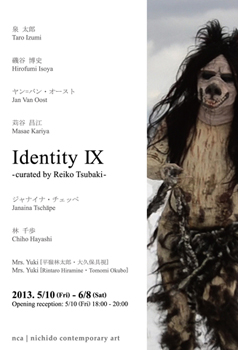 2013 5.10 - 6.8
2013 5.10 - 6.8

Installation >>
Opening reception:
5.10 Fri. 18:00 - 20:00
Artists: Taro Izumi (Japan) / Hirofumi Isoya (Japan) / Jan Van Oost (Belgium) / Masae Kariya(Japan) / Janaina Tschäpe (Germany) / Chiho Hayashi (Japan) / Mrs. Yuki [Rintaro Hiramine・Tomomi Okubo] (Japan)
Place: nca | nichido contemporary art
Date: May 10th (Fri.) – June 8th (Sat.) 2013
Reception: May 10th (Fri.) 18:00 – 20:00
Opening hours: Tue. – Sat. 11:00 - 19:00 / Closed on Sun. Mon. and National Holidays
Artists: Taro Izumi (Japan) / Hirofumi Isoya (Japan) / Jan Van Oost (Belgium) / Masae Kariya(Japan) / Janaina Tschäpe (Germany) / Chiho Hayashi (Japan) / Mrs. Yuki [Rintaro Hiramine・Tomomi Okubo] (Japan)
nca | nichido contemporary art is delighted to announce its ninth group exhibition entitled “identity IX.”
This exhibition is curated by Reiko Tsubaki, under the theme of “Identity” from her point of view. Several international artists are featured in the exhibition.
„Return to the Wild! Humans=Animals=Aliens?‟
The human self is formed with words, we are animals that construct society according to reason. Words that stipulate the consciousness and the ability to quantify numbers have produced a civilization that unifies all human activities and bases them on the exchange of money, giving birth to the capitalist system that has brought about huge advances in science, technology, and in the economic system. Yet could it not be said that as a result of capitalism‟s terminal symptoms, that humans have been reduced to mere cogs in these developed societies of control. Furthermore, as humans we have become arrogant towards nature, the planet isn‟t solely for the existence of humans. We seem to have forgotten that we are also a life-form that feeds parasitically off the planet.
For example, in a capitalist system that prioritizes function, the various desires, feelings and senses of living organisms, even the „sixth sense‟ instinct for survival that alerts us to danger, are looked down upon as base instincts and suppressed. Perhaps if people were able to maintain a co-existence with their wild nature and not be motivated by a lust for power and capital, then maybe the ravaging of the environments and the essentially destructive wars wouldn‟t happen. That is to say, humans seem to be in the process of losing our animal instinct, the power to interact with the unconscious territory and what we should call a sixth sense.
Before humans foolishly destroy the living creatures that inhabit this planet with disputes over power and territory, we should think about our friends who survived on the surface of this planet long before us, using not words, but instinct and untamed intuition. Also, If we were able to see ourselves as extraterrestrials might (the existence of which we seem close to proving), and then maybe we would come to realize that we too are aliens. Perhaps then we would have to doubt the premise of the rules and customs that exist within our civilization.
Taro Izumi seems to use animals that appear to act on different principles from humans as a metaphor to articulate the disparity and segmentation of the self.
Hirofumi Isoya is inspired by and makes work about the traits of insects that fly vertically towards the rays of the moon and stars that shine down upon the surface of the earth and inhabited this planet some four hundred million years before the existence of humans.
Mrs. Yuki[Rintaro Hiramine ・ Tomomi Okubo] are interested in the phenomenon of the heredity in living creatures. They make works by rearing ball pythons, which are a species that are considered to be motifs that represent gender, wisdom, the banished from Eden and the infinite.
Drawing out the feminine Eros and animal nature, Jan Van Oost‟s work presents a carnal existence vision of human existence.
Wearing an animal pelt, Masae Kariya metamorphoses into an existence somewhere between human and beast, regaining a chaotic, rich but impossible to verbalize primal status.
Perhaps more than humans, Janaina Tschäpe‟s artwork focuses on sprite-like chimeras, examining the boundary between human and chimera, or maybe even aliens.
Based on the true story of the extraction of Buddha‟s head from the stomach of a Buddhist statue in northern Thailand, Chiho Hayashi‟s absurd and comical video work uses the motif of childbirth while exploring the Buddhist concept of the infinite and conveying ideas that she draws from the unconscious.
By reflecting on other species, dissolving human identity and transgressing a human point of view, we would probably be able to reclaim the territory which cannot be expressed in words: the wild, the unconscious territory. This process might enable us to reach even towards the infinite or the universe.
As Claude Levi-Strauss wrote in The Savage Mind, “I believe the ultimate goal of the human sciences to be not to constitute, but to dissolve man.”
Reiko Tsubaki
Levi-Strauss, C. (1962) The Savage Mind. Hertfordshire, U.K.: The Garden City Press Ltd.
============================================================================================
Reiko Tsubaki
Associate Curator at Mori Art Museum and 2013‟s Guest Professor at Seian University of Art and Design. Tsubaki Reiko graduated from the Graduate School of Human and Environmental Studies at Kyoto University (Creative and Behavioral Science) and completed a DEA degree (Contemporary Art Criticism) at the University of Paris I Pantheon-Sorbonne. She joined the Mori Art Museum in 2002. She was in charge of number of exhibitions, including “Archilab”, “Africa Remix”, “Medicine and Art”, “French Window” and “Aida Makoto”. In the “MAM Project” series, she curated No.7, No.11, No.16 and preparing No.19. Outside of the Mori Art Museum, she curated “agnès b in Gion” (2004, Kyoto), “ShConemporary B.O.D.” (2008, Shanghai) and “The Cosmos as Metaphor” (2012, Kyoto). She also writes and gives lectures.
Support: AOYAMA | MEGURO / GALLERY TERRA TOKYO